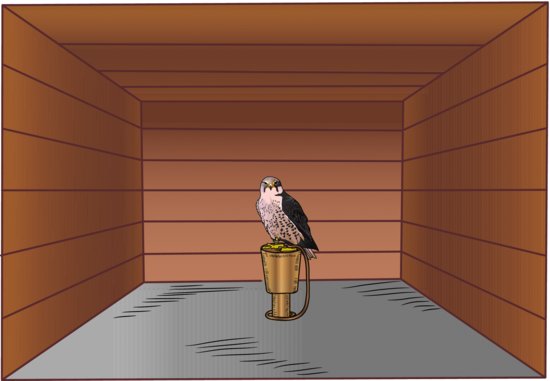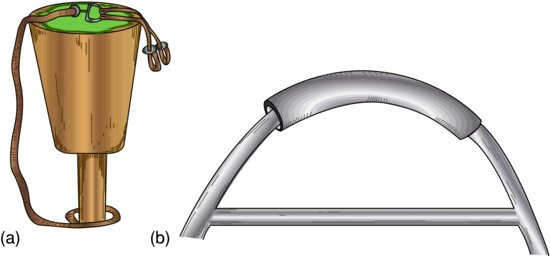Exposure to the changing daylight lengths is required for setting the diurnal and seasonal body clock of the bird. Another advantage of an outdoor enclosure is that it can be made sufficiently large to allow the bird(s) room to fly and exhibit other natural display activities. These outdoor enclosures are often referred to as aviary flights by owners and breeders and may be used to house several members of the same species or even mixed species exhibits.
Aviary flight construction
Construction
Aviary flights are generally constructed of wood and stainless steel. The flight flooring is made of solid concrete. This is preferable to a soil covering which can allow the build-up of pathogens and can be extremely difficult to clean. The rest of the flight is usually based on four stainless steel mesh sides supported by a hardwood or stainless steel frame. The roof is also of wire mesh, or clear corrugated plastic, and some form of nest box or enclosed roosting area, for breeding and extra protection during bad weather, is provided. Many of these flights are attached to the sides of houses, providing a solid wall to one side and the additional protection that the heat and eaves of the house offer.
Any wire mesh used to form the sides of the aviary flight should ideally be made from stainless steel, rather than a galvanised alloy to avoid the risk of zinc poisoning. The size of the mesh depends on the size of the species kept.
If wood is used, it should preferably be hardwood and must not have been treated with any potentially harmful wood preservatives, such as creosote.
It is sensible to provide a double-door system to gain entry to the aviary flight. Usually one door gives access to a corridor, from which each aviary flight has a door branching off. This helps to minimise the risk of a bird escaping during entering or exiting.
Another potential hazard of outdoor flights is the risk of rodent and wild bird access to the system. This can cause fouling of food and water bowl contents as well as the transmission of diseases. Care should be taken to ensure that the wire mesh is regularly inspected for signs of damage and that the food and water bowls are placed in a part of the cage with a solid roof over them to minimise faecal contamination by wild birds.
Positioning
Protection from the prevailing wind direction is important to prevent chilling. Equally important is to ensure that the nest or roosting box is not in direct sunlight all day. Temperatures will soar during the summer, leading to hyperthermia of adults and chicks alike. It is also useful to provide an area in the flight that protects from wind in the winter and provides shade in the summer. This allows the bird to alter its own microclimate at will, minimising environmental stresses.
Nest box
The nest or roosting box should be large enough to accommodate all birds housed in the flight and should be cleaned out regularly during the non-breeding season. During the breeding season, if breeding pairs are kept, the box should not be disturbed at all to avoid stress and mis-mothering of the eggs or young. It is also important to provide additional nest boxes if multiple pairs of breeding adults are kept together, so as to prevent intra- and inter-species aggression. The nest boxes should be waterproofed and positioned out of the prevailing wind and direct sunlight. They are generally constructed of marine plywood. This can lead to chewing of the boxes by the larger parrot species, and so some breeders coat the inside and outside of the box with stainless steel wire. Care should be taken of the material used for this, and the wire should not have sharp edges which may harm chicks inside the box.
Perches
Within the flight, perches made of hardwood should be provided. These should be of differing diameters, as discussed earlier, and be sufficient to provide all flight occupants with a perch. Food bowls may be clipped to the mesh sides of the flight or placed in an alcove recessed into one of the walls. Food and water bowls should not be placed in the roost or nest boxes, as fouling of the water and fights are much more likely to occur. Again, multiple tiering of perches, especially over food and water bowls, is to be avoided as it may lead to widespread contamination of food and water.
Substrate
If mixed-species aviary flights are used, ground-dwelling species, such as quail, are often included. In these cases some form of flooring substrate is required, with bark chips or peat being the most popular. Care should be taken in these cases to ensure that the flooring is kept very clean and that any Psittaciformes present do not start eating large quantities of substrate.
Raptors
Cage requirements
The cage requirements for raptors are different from those of Psittaciformes and Passeriformes. This is due to both the different environmental requirements of raptors and the reasons for which they are being kept. For example, many trained raptors are kept tethered for much of their lives, although there is a growing trend to keep them loose in an outside aviary system.
It is still necessary though for working raptors to be tethered for 2–4 weeks during their training period. The tethering device is the jess, a leather strap which is attached to each leg via an anklet at the tarsometatarsal area just above the foot. Each jess is the same length and is attached to a metallic swivel that allows rotation. This swivel is then attached to a leash. The leash may then be used to tether the bird to a perch, which is usually positioned close to the ground. It is important to keep the leash relatively short to prevent the bird reaching sufficient flight velocity before the leash becomes taut as this can seriously damage its legs.
Cage or shelter designs
Cages are generally sited outdoors and vary to suit the particular raptor and the presence or absence of tethering.
As with Psittaciformes and Passeriformes, the cage design should provide protection from the weather as well as from rodents and other potential pests and predators.
Tethered raptors
Raptors should only be kept tethered during the summer months as, by the very nature of tethering, the bird cannot move around or achieve shelter and so may die from exposure during the colder months or suffer frostbite.
During the summer months, this form of housing for a tethered raptor is known as a weathering (Figure 10.2). This is a three-sided, solid wooden construction, with a solid roof and open at the front. The perch is placed centrally on a floor covered with sand or gravel. Recommended dimensions for these shelters are 2.5 m × 2.0 m for Falconidae and 3.5 m × 2.5 m for hawks and eagles (Forbes & Parry-Jones, 1996).
Figure 10.2 Basic layout of a weathering for raptors: a three-sided and roofed building, usually of wood, with a gravel floor and open at the front. The bird is tethered to a perch in the centre.

This form of shelter is prone to two major problems. One is that during the summer, the weathering may become extremely hot, and so adequate shade must be provided to prevent heat stroke. Dehydration may also be a problem as most raptors (particularly Falconidae) obtain their water from their food and will not drink free water. The second problem is the risk of predation due to the open housing and the restrained, low position of the bird.
Aviary flights
These are often built along similar designs to the Psittaciformes and Passeriformes styles already mentioned. There is a major difference, though, in that raptors do not socialise well with other raptors, and so aviaries tend to contain individuals or a breeding pair and no others.
One of the more successful designs is a pattern similar to the weathering, except the front is covered with a wire mesh rather than being open. Roofing materials which have been found to minimise overheating during the summer, but are waterproof, include the compound Eternit®, which is a type of concrete matting (Forbes & Parry-Jones, 1996).
As with the aviary flights already mentioned, it is advisable to have a double-door system so as to avoid escapees. Food is often provided on a feeding block mounted on one side of the aviary, off the ground. It is accessed either directly from inside the aviary or from outside the aviary via an access hatch. Feeding frequency is generally geared to the appetite of the individual bird, but care must be taken as overfeeding non-working raptors with fatty prey such as laboratory rats can lead to atherosclerosis and obesity.
Water should be provided fresh each day, even for those species which do not routinely drink. Many free flight aviaries also provide some form of shallow bathing area, which should be kept scrupulously clean on a daily basis.
The floor should be of solid concrete, with excellent drainage to minimise the build-up of potential pathogens.
Perches
These depend on whether the bird is tethered or free flying. In tethered situations there are two types of perches (Figure 10.3).
Figure 10.3 (a) A block perch for falcons, with tether, metal swivel and jesses. (b) A bow perch for hawks with padding to prevent bumblefoot.

Stay updated, free articles. Join our Telegram channel

Full access? Get Clinical Tree


